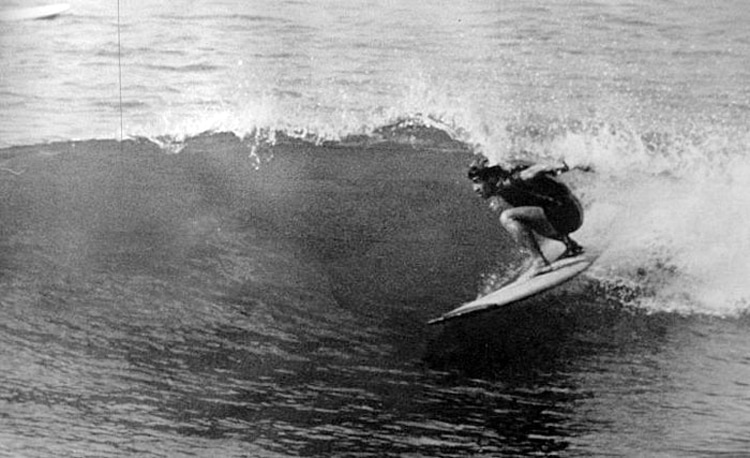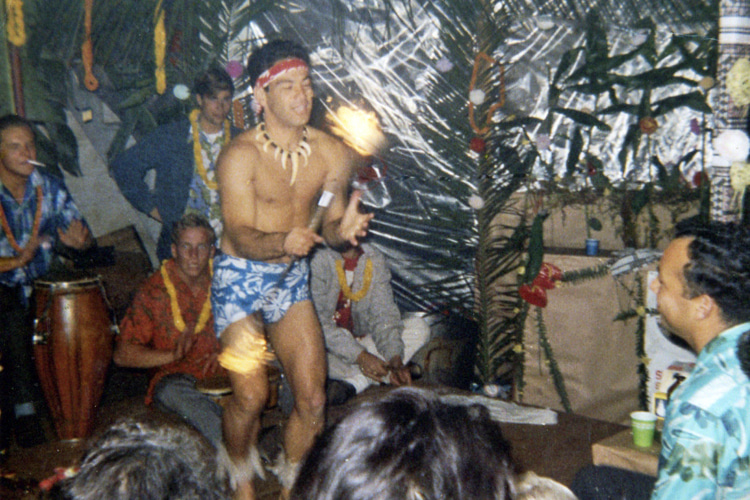One of the great things about being a surfer is getting to know a lot of Hawaiians. Babe Kane and his brother Billy were the first.
Babe was quiet and studious. Billy was effervescent and wild and always surfed with a beaming smile.
One time, I even saw him wiping out and going over the falls with that big grin.
In addition to surfing and skin diving, the brothers paddled the big outrigger canoes.
When Babe and Sue got married, the large Hawaiian community in the San Francisco Bay Area turned out for the event at their parents' home in Daly City.
They tore down back fences between their houses to connect four backyards. Half of the space was tented with plastic tarps tied to the houses.
At four in the morning, they started a large bonfire and heated a pile of lava rocks.
When the rocks were hot enough, they wrapped a 200-pound pig in banana leaves and put it into a large pit called the "imu."
All the Hawaiian aunties and uncles had flowers in their hair and leis. There was also a good contingent of haole (Caucasian) surfers in our best dress aloha shirts.
There was a true Hawaiian fun-loving spirit. This "spirit" was also enhanced by the large quantities of a sinister Hawaiian drink called "swipe."
Swipe is made from fermented pineapples, raisins, and sugar. The sinister part was the delicious fruit punch taste with the 90-proof punch.
A couple of Sue's friends from the secretarial school attended wearing high heels. One of them was quoted as saying how much they were enjoying the fruit punch.
They both actually passed out on the floor before the entertainment started.
There were ukuleles, guitars, drums, and about a hundred Hawaiians of all sizes and ages.

The Fire Knife Dance
As at all Hawaiian parties, there was lots of dancing and loud laughter. Frankly, I don't remember much else.
It doubtlessly had to do with the swipe-induced stupor. But one memory shines through. It was the climactic highlight of the entertainment under the tent that night.
Frankie Freitas, aka "Chief Tapu," took the stage.
Frankie, a Pedro Point surfer, earned extra money doing the Tahitian fire knife dance in nightclubs.
He came on stage wearing a lei (Haku), a loincloth (malo), a headband, and flowered anklets. He lit the torches.
The Tahitian war chant music started throbbing from the sound system. Drummers kept the beat.
Chief Tapu's torches blurred with whirling flame and smoke as he swung them around to the music.
Without missing a beat, he put the torches in a bucket and grabbed the "Siva Afi," the fire knives.
The large knives glinted in the smoky light as Frankie sliced the air around his body and under his legs.
Something's Wrong
Just as the music reached the crescendo, thwack went the machete.
A big chunk of Frankie's heel went somersaulting through the air over the open-mouthed spectators.
Plop.
It landed right in the middle of a big bowl of poi. Frankie fell to the floor, screaming and holding what was left of his foot.
A couple of the big Hawaiians jumped up on the stage and carried him to a car to take him to the hospital.
Then one of them came running back, looking for the heel. He grabbed it out of the bowl of poi and went running back out to the car.
Chief Tapu subsequently opened up a breakfast and burger restaurant in Santa Cruz. He doesn't limp much.
But if you go in and want to make him wince, just ask him about Babe Kane's wedding.
Words by Robert Caughlan | Environmentalist, Surfer, and Author of "A Surfer in the White House"
